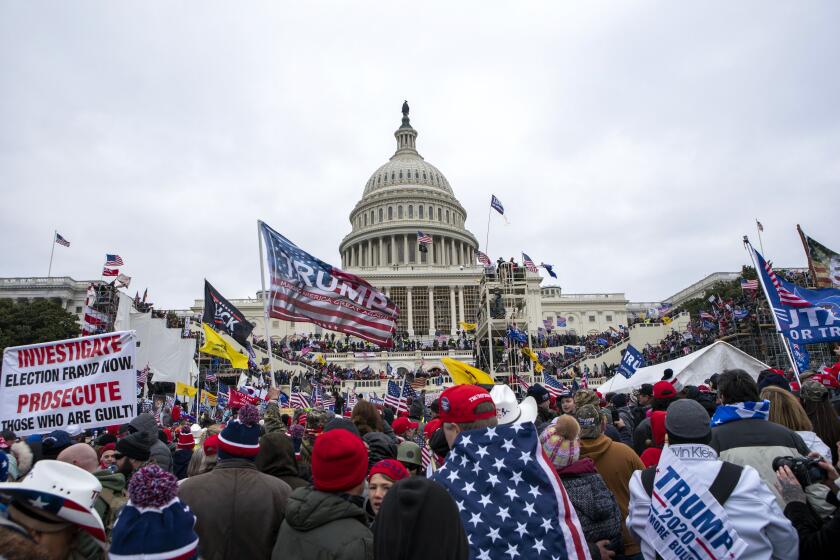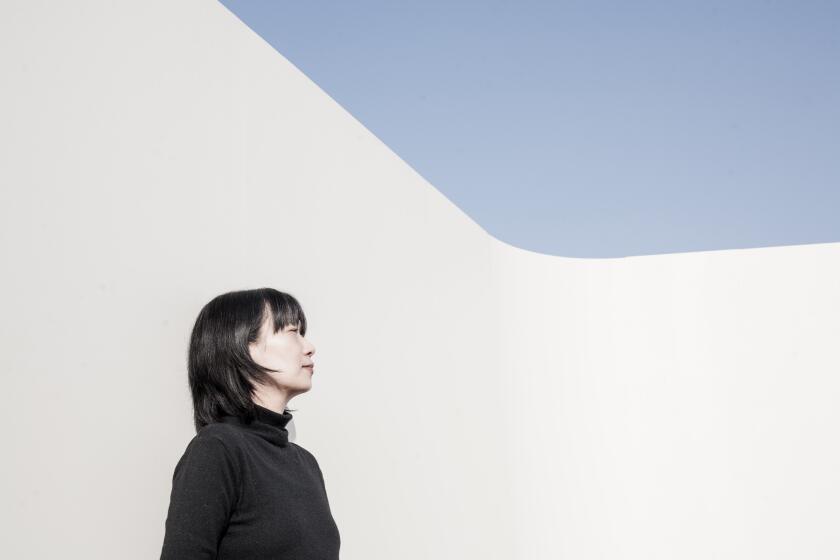Student Protests Expand in Seoul : Police Attacked, Square Seized as Tens of Thousands March Against Regime
Tens of thousands of student protesters, cheered on by office workers and pedestrians, marched through the streets here Thursday chanting, “Destroy the dictatorship!” and “Revise the constitution!” in the greatest outpouring yet of anti-government sentiment.
Over a three-mile area, students battled an estimated 20,000 police with firebombs and rocks, smashing the windows of police vans and setting fire to at least two police vehicles. Three police substations were attacked and two were ransacked.
In one dramatic incident, students overwhelmed about 80 riot policemen and briefly seized the main square facing the Bank of Korea in the heart of Seoul. The policemen, who had run out of tear gas, were surrounded by demonstrators. The students snatched the officers’ helmets, shields and gas masks and made two bonfires of the equipment, sending black smoke billowing into the sky.
Police Beaten, Kicked
Some of the disarmed officers begged for mercy as they were beaten and kicked. Others sought shelter in a fountain and got drenched. Student leaders finally restored calm, and the frightened policemen were led back to their lines through the milling demonstrators. Some of the students and policemen shook hands as they parted.
Other violent clashes were reported in the cities of Pusan, Inchon, Taegu, Masan, Taejon and Wonju. Protesters in Wonju, southeast of Seoul, captured the municipal police chief and beat him, then set him free.
Opposition groups had billed Thursday as “Anti-Tear Gas Day” and demanded that the authorities stop using the powerful irritant to suppress political dissent. “Expel tear gas from our land,” many of the protesters chanted.
But the police, who do not carry guns, fired thousands of tear gas canisters at the crowds; the demonstrators, seemingly undeterred, stood their ground and fought back.
In terms of scope and emotional intensity, the disturbance in Seoul was the worst since the current round of protests against the government of President Chun Doo Hwan began on June 10. That was the day former Gen. Chun’s ruling Democratic Justice Party nominated Roh Tae Woo, its chairman and Chun’s handpicked successor, as its candidate to succeed Chun in February.
Not a Direct Election
The election, to take place later this year, is not to be a direct election. The president is to be chosen by an electoral college, and many South Koreans are convinced that the indirect election will guarantee a continuation of what they regard as military rule. Roh, also a former general, helped put Chun in power seven years ago in a coup.
The disturbances of June 10 were generally limited to a square-mile area of central Seoul around the Myongdong Roman Catholic Cathedral, but Thursday’s demonstrations extended across a broad expanse, from the vicinity of Seoul Central Railway Station to the East Gate Market.
Disturbances also erupted in and near the City Hall Plaza, where visiting foreign officials are often received.
The protests began about 4 p.m. and did not taper off until seven hours later, shortly before bus and subway service was suspended for the night. Activity in the center of Seoul was seriously disrupted for more than four hours. Auto traffic was paralyzed on many main arteries, as demonstrators seized streets and freeway overpasses.
The turmoil ended a two-day lull in this capital of 10 million people and mocked government attempts to defuse student protests by closing 36 college campuses ahead of schedule and before final examinations.
Police said 1,032 demonstrators were arrested Thursday in 10 cities, while 621 policemen were injured, the Associated Press reported. No figures were given on injuries to demonstrators.
The focal points for Thursday’s activity were rallies scheduled at two churches to protest police use of pepper gas, a virulent and powdery form of tear gas that causes temporary blindness and a burning sensation on the skin.
Student Brain Dead
National police headquarters issued a statement Thursday saying that officers have been instructed not to fire gas canisters directly at protesters, but to aim at a point 30 feet over their heads. Last week, such a canister hit a university student in the head, causing injuries that left him in a coma. He has been declared brain dead but has not been removed from a respirator.
The police statement defended the use of pepper gas as “a harmless, defensive tool” necessary to avert worse confrontations.
As soon as the Korea National Council of Women and the new National Coalition for a Democratic Constitution, an alliance of opposition politicians, churchmen and dissidents, announced plans for the separate rallies, Chun’s government banned them. But the protesters paid no heed.
The trouble started when about 3,000 people, many of them women belonging to the national council, tried to make their way to the Yondong Presbyterian Church near the East Gate Market, for the first scheduled rally. So much gas was fired there that it was still being felt two hours later at the Myongdong Cathedral, two miles away, where another crowd of about 10,000 people gathered for the scheduled rally there.
Students filled the driveway leading up a hill to a plaza in front of the cathedral, which was built in 1898 and serves as headquarters for South Korea’s 2 million Catholics. Lining the sidewalks on both sides and standing at the edge of the plaza overlooking the street below were women in fashionable dresses and high heels, businessmen in suits, men in workers’ clothing and large numbers of people in their 60s and older.
“Tell Americans we need the United States to come out with a clear stand against this government,” a man in his 40s, dressed in a suit, said in English. “That is very important to us.”
He refused to give his name but identified himself as an executive of a Korean construction company.
A university student who said he was a junior, majoring in genetic engineering, said, “We’ve got to get democracy in Korea, sooner or later.”
A police bus that pulled up to the cathedral gate was driven off by a shouting crowd. When a group of students locked arms and marched out of the cathedral compound, the police moved in and fired volleys of gas. Three or four canisters landed on the cathedral grounds.
Fighting erupted in front of and around the Chosun, Plaza and Lotte hotels. Barrage after barrage of gas scattered student marchers and onlookers. Each volley brought boos and shouts of anger at the policemen.
The opposition Reunification Democratic Party, a member of the coalition, issued a statement urging the protesters to stop the violence and “conduct the struggle for democracy in a peaceful manner.” The statement condemned the government for “causing the present situation by the use of tear gas to foil peaceful, nonviolent rallies.”
Candidate Roh, who met with President Chun on Wednesday night, told reporters Thursday that “we are ready to reflect in our party’s political schedule the people’s aspirations for revision of the constitution.”
The statement was taken to mean that the ruling Democratic Justice Party would be willing to immediately reopen talks on revising Chun’s authoritarian 1980 constitution. On April 13, Chun suspended the talks until October, 1988, after the Olympic Games, which are scheduled to take place here.
“It’s a meaningless gesture,” a middle-aged man at the Myongdong Cathedral said, pointing to a headline in an evening newspaper reporting Roh’s offer. “Besides, you can’t believe anyone in this government.”
U.S. Ambassador James R. Lilley today delivered a letter from President Reagan to Chun, the U.S. Embassy here confirmed. The Jong-an newspaper reported that Reagan called on Chun “to take steps toward establishing full democracy.” However, the embassy refused to comment about the substance of the letter.
Roh told reporters that the ruling party “will work out measures to cope with the present situation, respecting as much as possible public opinion and the people’s aspirations as demonstrated by recent developments.”
Other ruling party officials suggested that Chun might consider releasing political prisoners. And they passed along, unofficially, word that the party might allow the people to vote in a national referendum to express approval or disapproval of Chun’s decision to suspend talks on constitutional reform until after the Olympics.
Roh’s statement and the hints dropped by the other party officials appeared to be aimed at persuading Kim Young Sam, president of the Reunification Democratic Party, to agree to meet with Roh to seek a solution to the growing political problem.
“We welcome the Democratic Justice Party’s understanding, although it is rather belated, that the April 13 decision was made contrary to the people’s wishes,” said Kim Tae Ryong, a spokesman for the Reunification Democratic Party.
But he ruled out any meeting while those arrested since June 10 are in jail and while Kim Dae Jung, another opposition leader, is under house arrest.
“The constitution should be revised before President Chun steps down next February,” the opposition spokesman said.
Roh’s offer underscores the depth of government concern over the rising turmoil, which spread Wednesday to Pusan, the country’s second largest city with 3.5 million people.
More to Read
Sign up for Essential California
The most important California stories and recommendations in your inbox every morning.
You may occasionally receive promotional content from the Los Angeles Times.










